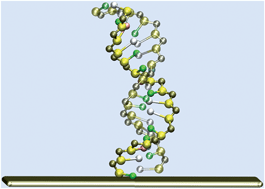Molecular pathways in DNA-DNA hybridization of surface-bound oligonucleotides
Abstract
A molecular model of DNA, that has been shown to reproduce hybridization, is used here to study the transition from two single-stranded molecules to a double-helical complex in situations where one strand is attached to a surface. Transition Path Sampling simulations reveal that hybridization is initiated by forming specific contacts between distinct bases of the molecule. Molecules with repetitive sequences form double helices by sliding along each other after having formed initial contacts. For random sequences, it is shown that the pathway that molecules follow to hybridization depends on the linker length as well as the temperature, and is significantly different from that observed in the bulk.


 Please wait while we load your content...
Please wait while we load your content...